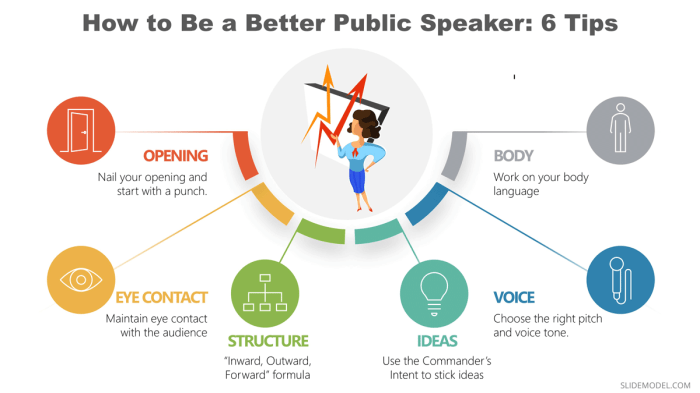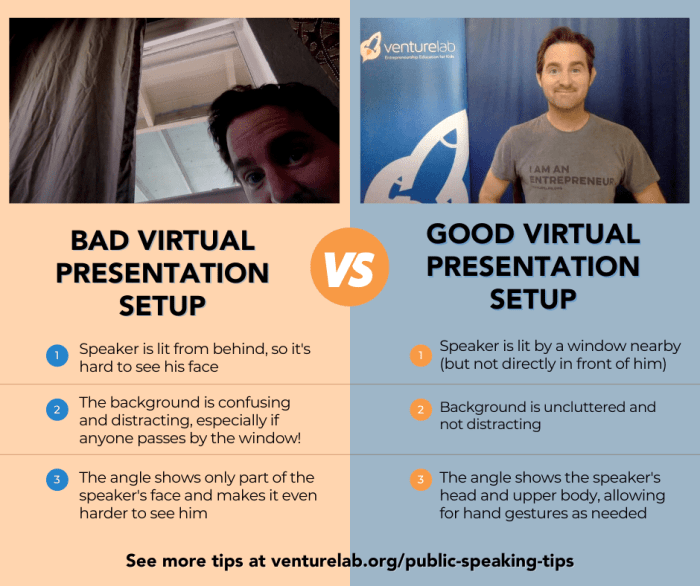Public Speaking Tips: Are you ready to take your communication skills to the next level? Dive into this guide filled with practical advice and strategies to help you conquer your fear of public speaking and deliver powerful presentations with confidence. From overcoming anxiety to engaging your audience, this comprehensive overview covers everything you need to know to become a skilled public speaker.
Whether you’re a seasoned presenter looking to enhance your skills or a novice seeking guidance, these tips will empower you to communicate effectively and leave a lasting impact on your audience. Get ready to unleash your inner orator and captivate any crowd with your newfound public speaking prowess.
Introduction to Public Speaking Tips
Public speaking is the art of communicating effectively in front of an audience. It is a crucial skill that can open up numerous opportunities and enhance one’s personal and professional growth. Mastering public speaking skills can boost confidence, improve communication abilities, and help individuals convey their ideas with impact.
Benefits of Mastering Public Speaking Skills
- Increased confidence: Public speaking can help individuals overcome fear and develop self-assurance.
- Enhanced communication skills: The ability to articulate thoughts clearly and concisely is a valuable asset in various aspects of life.
- Career advancement: Strong public speaking skills can differentiate individuals in the workplace and lead to better job opportunities.
Examples of Situations Where Public Speaking Skills are Crucial
- Presenting in class: Whether giving a presentation or participating in a debate, public speaking skills are essential for academic success.
- Job interviews: Being able to express oneself effectively can make a lasting impression on potential employers.
- Speaking at events: From weddings to conferences, public speaking skills can help individuals engage and captivate an audience.
Overcoming Fear of Public Speaking
Public speaking can be intimidating for many people, but with the right strategies, it is possible to overcome the fear and become a confident speaker. Here are some common reasons for fear of public speaking and practical tips to manage and reduce public speaking anxiety.
Common Reasons for Fear of Public Speaking
- Fear of judgment from others
- Lack of confidence in speaking abilities
- Feeling unprepared or not knowing the topic well
- Past negative experiences with public speaking
Practical Tips to Manage Public Speaking Anxiety
- Practice and prepare thoroughly before the speech
- Breathing exercises to calm nerves before speaking
- Visualize a successful speech and positive outcomes
- Focus on the message you want to convey, rather than yourself
- Start with small speaking engagements to build confidence gradually
Personal Anecdotes of Overcoming Fear of Public Speaking
“I used to dread public speaking, but after taking a public speaking course and practicing regularly, I became more comfortable and even started enjoying it. Now, I volunteer to speak at events whenever I can.”
Preparation Techniques for Effective Public Speaking
Effective public speaking requires thorough preparation to ensure a successful presentation. It involves researching the audience and topic, as well as organizing the content in a coherent manner.
Researching the Audience and Topic
When preparing for a speech or presentation, it is crucial to research the audience to understand their interests, knowledge level, and expectations. This information will help tailor your content to resonate with the audience and ensure engagement. Additionally, thorough research on the topic will enable you to provide accurate information and establish credibility with the audience.
Organizing Content for a Coherent Message, Public Speaking Tips
To deliver a coherent message, it is essential to organize the content of your speech or presentation effectively. Start by outlining the main points you want to cover and then arrange them in a logical sequence. Use transitions to connect ideas smoothly and maintain the flow of the presentation. Consider using visual aids or examples to support your points and enhance audience understanding.
Delivery Strategies and Tips: Public Speaking Tips

When it comes to public speaking, your delivery is just as important as the content of your speech. How you present yourself can greatly impact how your message is received by the audience.
Body Language in Public Speaking
Body language plays a crucial role in public speaking as it can convey confidence, credibility, and connection with the audience. Here are some tips for using body language effectively:
- Make eye contact with your audience to establish a connection and show confidence.
- Use gestures to emphasize key points and keep the audience engaged.
- Stand up straight and maintain good posture to appear confident and authoritative.
- Smile to appear approachable and friendly.
- Avoid fidgeting or pacing, as it can be distracting to the audience.
Engaging the Audience
Engaging the audience is essential to keeping their attention and making your speech memorable. Here are some tips to help you connect with your audience:
- Start with a compelling opening to grab the audience’s attention from the beginning.
- Use stories, anecdotes, or humor to make your speech more relatable and interesting.
- Ask questions or involve the audience in some way to create interaction.
- Use visuals or props to support your points and make the presentation more dynamic.
- Invite feedback or questions to encourage participation and make the audience feel involved.
Vocal Variety and Tone
Your voice is a powerful tool in public speaking, as it can convey emotion, emphasis, and meaning. Here are some tips for using vocal variety and tone effectively:
- Adjust your volume and pace to keep the audience engaged and emphasize important points.
- Use pauses to create suspense, allow time for reflection, and emphasize key ideas.
- Vary your pitch and tone to convey different emotions and maintain interest.
- Practice modulation to avoid a monotone delivery and keep the audience attentive.
- Pay attention to your articulation and pronunciation to ensure clarity and understanding.
Handling Q&A Sessions

When it comes to handling Q&A sessions after a public speaking engagement, preparation is key. Being ready to address various questions from the audience can help you appear confident and knowledgeable. Here are some tips to help you manage questions effectively.
Prepare in Advance
- Anticipate potential questions based on your presentation content.
- Practice answering questions with a friend or colleague to simulate the Q&A experience.
- Research common questions related to your topic to be well-informed.
Strategies for Difficult Questions
- Stay calm and composed when faced with a challenging question.
- Repeat or rephrase the question to ensure you understand it correctly.
- Acknowledge the difficulty of the question if necessary, but remain confident in your response.
- Avoid getting defensive or confrontational; instead, address the question with respect and professionalism.
Successful Response Examples
“That’s an interesting point you’ve raised. Let me provide some additional context to address your concern.”
- Offering to follow up with more information shows your willingness to engage further.
- Using phrases like “I appreciate your perspective” can help establish a positive rapport with the audience.
- Redirecting a difficult question to a related topic you’re more comfortable discussing is a valid strategy.
Improving Public Speaking Skills through Practice
Practice makes perfect, especially when it comes to public speaking. The more you practice, the more confident and proficient you will become in delivering effective speeches.
Exercises and Activities to Enhance Public Speaking Skills
- Impromptu Speaking: Practice speaking on a random topic for a few minutes without any preparation. This will help improve your ability to think on your feet.
- Record Yourself: Record your speeches or presentations and watch them back to analyze your body language, tone, and delivery. This will help you identify areas for improvement.
- Join a Toastmasters Club: Toastmasters International is a great organization where you can practice public speaking in a supportive environment and receive constructive feedback.
Benefits of Joining Public Speaking Clubs or Groups
- Opportunity to Practice Regularly: Joining a public speaking club or group provides you with regular opportunities to practice speaking in front of an audience.
- Receive Constructive Feedback: Members of these clubs are usually supportive and provide valuable feedback to help you improve your speaking skills.
- Build Confidence: By speaking regularly in a club setting, you can gradually build your confidence and overcome any fear of public speaking.
Tips for Receiving Constructive Feedback to Improve Speaking Abilities
- Be Open-Minded: Listen to feedback with an open mind and consider how you can apply it to enhance your speaking skills.
- Ask Specific Questions: When seeking feedback, ask specific questions about areas you want to improve, such as vocal variety or body language.
- Practice Implementing Feedback: Actively work on incorporating feedback into your speeches and presentations to see improvement over time.
Technology and Public Speaking
Technology plays a significant role in enhancing public speaking skills and presentations. It offers various tools and resources that can help speakers engage with their audience more effectively. However, if not used properly, technology can also detract from the overall impact of a speech.
Tools and Resources for Improving Presentation Skills
Utilizing technology can provide speakers with numerous tools and resources to enhance their presentation skills. Some of the key resources include:
- Presentation software like PowerPoint or Keynote for creating visually appealing slides.
- Teleprompter apps to help speakers stay on track with their speech.
- Video recording devices for practicing and reviewing presentations.
- Online courses and tutorials for learning advanced public speaking techniques.
Using Visual Aids Effectively
Visual aids can significantly improve the audience’s understanding and retention of the presentation content. Here are some tips for using visual aids effectively:
- Avoid overcrowding slides with too much text or images. Keep them simple and easy to read.
- Use visuals to complement your speech, not distract from it. They should enhance your message, not overpower it.
- Practice with your visual aids to ensure they flow seamlessly with your presentation.
- Make sure all visuals are clear, relevant, and add value to your speech.